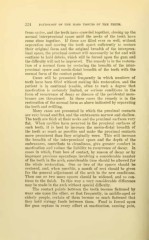Page 362 - My FlipBook
P. 362
224 PATHOLOGY OF THE HABD TISSUES OF THE TEETH.
from caries, and the teeth have crowded together, closing up the
normal interproximal space until the necks of the teeth have
come close together. If these are filled ever so well, without
separation and moving the teeth apart sufficiently to restore
their original form and the original breadth of the interprox-
imal space, the proximal contact will necessarily be flat and will
continue to hold debris, which will be forced upon the gum and
the difficulty will not be improved. The remedy is in the restora-
tion of a normal form by restoring the breadth of the inter-
proximal space and mesio-distal breadth of the teeth with the
normal form of the contact point.
Cases will be presented frequently in which numbers of
teeth have been filled without making this restoration, and the
patient is in continual trouble, often to such a degree that
mastication is seriously limited, or serious conditions in the
form of recurrence of decay or disease of the peridental mem-
branes are threatened. In these cases the remedy is in the
restoration of the normal form as above indicated by separating
the teeth and refilling.
Many cases are presented in which the proximal contacts
are very broad and flat, and the embrasures narrow and shallow.
The teeth are thick at their necks and the proximal surfaces very
flat. "When cavities have occurred in the proximal surfaces of
such teeth, it is best to increase the mesio-distal breadth of
the teeth as much as possible and make the proximal contacts
more prominent than they originally were. This will increase
the breadth of the interproximal space and the depth of the
embrasures, contribute to cleanliness, give greater comfort in
mastication and reduce the liability to recurrence of decay. In
cases in which, from loss of contact, by reason of decay or by
improper previous operations involving a considerable number
of the teeth in the arch, considerable time should be allowed for
the whole restoration. One or two of the spaces should be
restored, and, when possible, a month of rest should be given
for the general adjustment of the arch to the new conditions.
Then one or two more spaces should be widened, and so con-
tinue to the finish. In this way a very considerable difference
may be made in the arch without special difficulty.
The contact points between the teeth become flattened by
wear one upon the other, so that frequently, in middle-aged or
elderly people, certain of them become so much flattened that
they hold stringy foods between them. Food is forced upon
the gum septum in every effort at mastication, causing pain,


